Emergency department models of care in Queensland: a multisite cross-sectional study
Anthony Bell A B C I , Ghasem-Sam Toloo A , Julia Crilly D E , John Burke A B C , Ged Williams F H , Bridie McCann G and Gerry FitzGerald AA Queensland University of Technology, School of Public Health and Social Work, Kelvin Grove, Qld 4059, Australia. Email: sam.toloo@qut.edu.au; john.burke@health.qld.gov.au; gj.fitzgerald@qut.edu.au
B University of Queensland, School of Medicine, Herston, Qld 4006, Australia.
C Department of Emergency Medicine, Royal Brisbane and Women’s Hospital, Herston, Qld 4006, Australia.
D Department of Emergency Medicine, Gold Coast Hospital, Southport, Qld 4215, Australia. Email: julia.crilly@health.qld.gov.au
E School of Nursing and Midwifery, Menzies Health Institute Queensland, Griffith Health Centre, Gold Coast Campus, Griffith University, Qld 4222, Australia.
F Griffith University, Gold Coast Campus, Qld 4222, Australia. Email: ged_williams@hotmail.com
G Metro North Hospital Health Service, Herston campus, Qld 4006, Australia. Email: Bridie.McCann@health.qld.gov.au
H Present address: SEHA (Abu Dhabi Health Service), Khalidia, PO Box 109090, Abu Dhabi, UAE.
I Corresponding author. Email: Anthony.Bell@health.qld.gov.au
Australian Health Review 43(4) 363-370 https://doi.org/10.1071/AH17233
Submitted: 17 October 2017 Accepted: 26 March 2018 Published: 7 September 2018
Journal Compilation © AHHA 2019 Open Access CC BY-NC-ND
Abstract
Objective The acuity and number of presentations being made to emergency departments (EDs) is increasing. In an effort to safely and efficiently manage this increase and optimise patient outcomes, innovative models of care (MOC) have been implemented. What is not clear is how these MOC reflect the needs of patients or relate to each other or to ED performance. The aim of this study was to describe ED MOC in Queensland, Australia.
Methods Situated within a larger mixed-methods study, the present study was a cross-sectional study. In early 2015, leaders (medical directors and nurse managers) from public hospital EDs in Queensland were invited to complete a survey detailing ED activity, staffing profiles, treatment space, MOC and National Emergency Access Target (NEAT) performance. Routinely collected ED information system data was also used.
Results Twenty of the 27 EDs invited participated in the study (response rate 74%). An extensive array of MOC were identified that were categorised into those that facilitate input, throughput and output from the ED. There was no consistent evidence as to the relative effectiveness of these MOC in achieving ED performance benchmarks, such as NEAT performance.
Conclusion There is considerable variability in the MOC used throughout EDs in Queensland. A more complete analysis of the relative effectiveness of different MOC either in isolation or as part of a comprehensive approach would help inform more consistent MOC in Queensland EDs.
What is known about the topic? MOC in any given ED are implemented in response to factors such as the geographical location of the hospital, hospital-specific characteristics and service profile, staffing profile and patient demographic profile. In the era of time-based targets, they may also serve to address a particular aspect of flow in the face of rising ED demand. Although many of the MOC attempt to deal with flow in a linear fashion, target specific phases of the ED journey or address particular patient cohorts, what is clear is that not all EDs are shaped and formed the same.
What does this paper add? The study provides a comprehensive description of the varied models of care operating within Queensland public hospital EDs and how they relate to ED performance. A basic taxonomy of contemporary ED MOC is necessary to allow comparison between departments and inform decisions regarding safety, efficiency and cost-effectiveness.
What are the implications to practitioners? A contemporary understanding of the presence and profile of ED MOC that currently exist within a network of hospitals and health services is important for managers, clinicians and patients to inform decision-making regarding the safety, clinical effectiveness and cost-effectiveness of these models. This understanding can also inform where and how further improvements in care delivery can progress.
Additional keywords: medical workforce, nursing workforce.
Introduction
Within the climate of increasing emergency department (ED) presentations,1–3 there is awareness of poor outcomes when delays to patient admission result in congestion of the ED.4,5 These delays are related to hospital crowding, fiscal constraint and the need to meet national standards and 4-h performance targets.6 Recent Australian research has identified an inverse relationship between 4-h performance targets (i.e. National Emergency Access Target (NEAT)) and hospital standardised mortality ratio for patients admitted from EDs; these improvements in mortality appear to plateau once overall NEAT compliance reaches 80% and in-patient NEAT exceeds 60%.7
More recently, discharge delay has been identified8 as a key contributor to excess ED length of stay (LOS). By identifying the critical transition points in a patient’s ED journey across hospital services, modelling validates the perceived benefits of driving workflow improvements to reduce treatment delay, in particular discharge delay, whereby even small improvements in bed allocation and transfer processes can have a significant effect on 4-h performance.8 Operational initiatives have been recommended that prioritise workflow improvements to streamline in-patient bed booking and transfer processes.8 Furthermore, a recent analysis of ED 4-h performance failed to demonstrate a correlation with staffing levels or cubicle numbers, once again emphasising the importance of efficient ED workflows and the contribution of whole-of-hospital factors.9
A variety of models of care (MOC) have been described in the literature that aim to address the effect of increasing demand on ED services. These models are often implemented in order to address a particular aspect of flow (i.e. input, throughput or output issues),10 and are often implemented in isolation from existing models or without comprehensive evaluation of the effect in other parts of the system.11 There is also considerable heterogeneity in the structure and function of generic concepts, such as short stay units (SSU) and fast track units, according to factors such as the geographical location of the hospital, hospital-specific characteristics and service profile, staffing profile and patient demographic profile.12
A basic taxonomy of contemporary ED MOC is necessary to allow comparison between departments and inform decisions regarding safety, efficiency and cost-effectiveness.
The aim of this study was to provide a comprehensive description of the profile of MOC operating within Queensland public hospital EDs to contribute to an understanding of the way in which different models relate to each other and may affect ED performance.
Methods
The present study was a retrospective cross-sectional survey of Queensland public hospital EDs.
Managers (nursing and medical) from all 27 Queensland public hospital EDs were invited (in writing, via email and telephone) to participate in the study.
The questionnaire was developed by an expert panel and tested for face and content validity. The questionnaire was designed to collect detailed information about the capacity, activities, staffing, and operational MOC of the hospitals and EDs pertaining to the 2013–14 financial year.
MOC included in the questionnaire were based on a review of the literature 12 and focused on three main stages of the patient journey within the ED (input, throughput and output).10 ED managers were asked to note whether the model was used within their ED and, if so, how these models operated. The questionnaire was distributed via email in early 2015 to ED medical and nursing managers who accepted the invitation for their site to participate. Offers of telephone or face-to-face support to answer questions regarding the questionnaires were provided. Follow-up reminders (via email and telephone) were undertaken for sites that had not responded within 8 weeks.
Data were analysed using descriptive statistics, including measures of central tendency, such as median and interquartile range or mean ± s.d. (depending on data distribution), to describe the participating sites. Data were analysed using Microsoft (Bellevue, WA, USA) Excel (2010).
The study was approved by the Gold Coast Hospital and Health Service (HREC/12/QGC/189) and Queensland University of Technology (1300000701) human research ethics committees.
Results
Twenty of the 27 (74%) EDs invited participated in the study. Three EDs were deemed ineligible. These included two tertiary children’s hospitals that merged during the study period and another ED that was redeveloped during the study period. As defined by the Australian Institute of Health and Welfare (AIHW),13 the 20 participating EDs included four Principal Referral, 11 Group A and five Group B hospitals with urban and regional representation. Overall NEAT for all participating EDs ranged from 73% to 79% (target = 80%). Admitted NEAT (comprised of in-patient and SSU NEAT) ranged from 51% to 59%, and non-admitted NEAT ranged from 84% to 88%. The distribution of ED treatment spaces and layout are presented in Table 1. The built environment (layout) of most EDs was cellular (pod) style, and the number of treatment spaces differed according to hospital type, with most in Principal Referral hospital EDs.
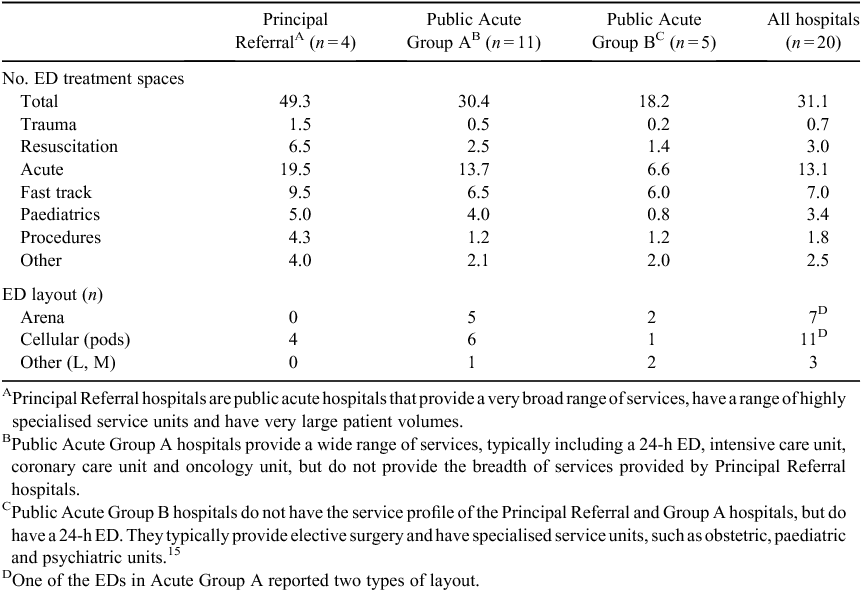
|
MOC reported by EDs are categorised in this paper according to their principal effect on intake into the ED (as opposed to input), throughput within the ED and output from the ED.
Intake strategies
Intake strategies include those designed to provide rapid induction of the patient into the ED assessment process, whether by expediting triage or by adopting alternative methods of queuing and cohorting patients to improve time to medical contact (see Table 2).
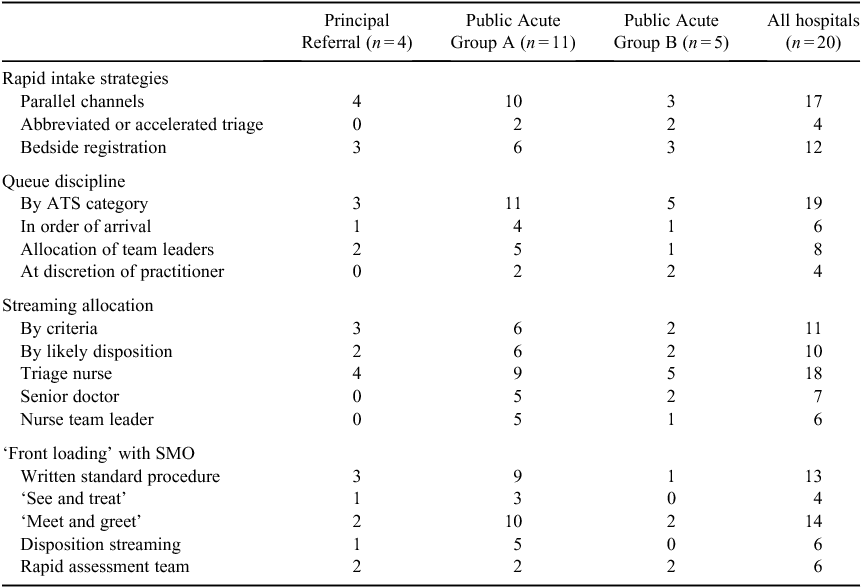
|
Most EDs (85%; n = 17) used separate triage points for ambulance and walk-in patients, as well as some means of deferring registration until the patient was in a bed (60%; n = 12). Most continued to use Australasian Triage Scale (ATS) categories as the preferred mechanism to queue patients waiting to be seen (95%; n = 19), although 30% (n = 6) also reported seeing patients in order of arrival in some areas after streaming had occurred, with 20% (n = 4) reporting that this could also be discretionary.
Larger hospitals were more likely to divide their caseload into clinical streams, mostly according to likely disposition (admit vs discharge) and usually at the discretion of the triage nurse (90%; n = 18). This process was dictated by specific criteria in 55% of EDs (n = 11), and in some cases streaming was further refined by senior medical or nursing input, either at the point of triage or following preliminary workup.
The larger hospitals were also more likely to dedicate a senior medical officer (ED physician or registrar) to the task of ‘front loading’, or early assessment and/or intervention. There was a great deal of variability between departments in the application of this concept, the most common (70%; n = 14) being a ‘meet and greet’ function to delegate workup and disposition plans for junior resident staff. Occasionally (n = 6) this role formed part of a rapid assessment team operating in a dedicated clinical area. Four EDs used senior staff in a ‘see and treat’ capacity to promote early discharge. Formalised internal handover following ‘front loading’ occurred in just three hospitals.
Throughput models
Throughput models describe those that seek to enhance the efficiency of a patient’s time as they move through ED processes. Only three departments were set up to function within pods (i.e. discrete work zones). Patient flow decision making involved a shift coordinator in most EDs (n = 15), whereas other EDs sought to coordinate patient flow by Senior Medical Officer (SMO) (n = 11) or a dedicated navigator (n = 6) using the ED information system. Finally most departments employed allied health staff as alternate service providers, with pharmacists and social workers being most prevalent (see Table 3).
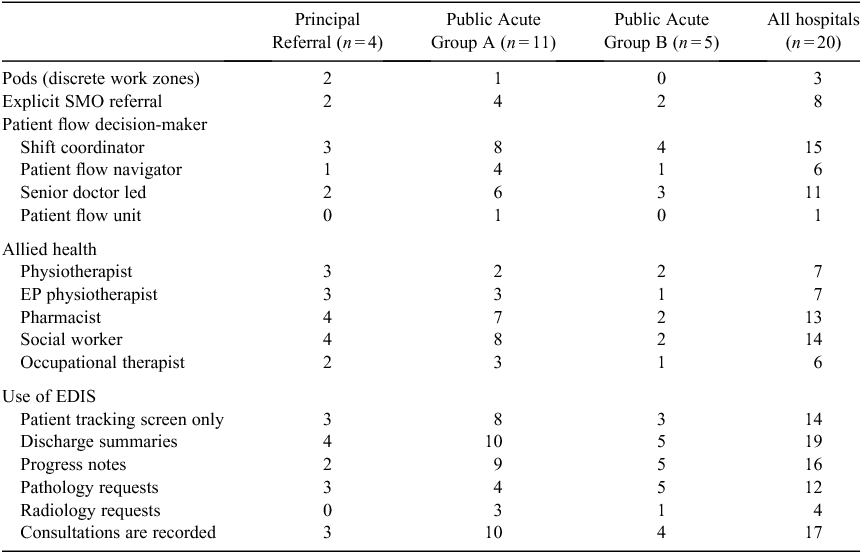
|
A specific time target for a disposition decision was reported in only 15% (n = 3) of EDs. Once disposition had been determined, patients remained in their original cubicle (n = 8), were transferred to a step-down area in the ED (n = 5) or were transferred to an assessment area (e.g. medical assessment unit (MAU) or equivalent; n = 6). The remainder were unspecified. For admitted patients, a senior medical referral model (consultant or registrar) was specified in one ED, with all others reporting that consultants or registrars, resident medical officers or nurse practitioners (where present) made referrals.
Furthermore, clinical pathways were used in 85% (n = 17) of EDs. Chest pain pathways were ubiquitous, with pathways for stroke, febrile neutropenia, trauma, sepsis, fractured neck of femur and paediatrics commonly reported (see Table 4).
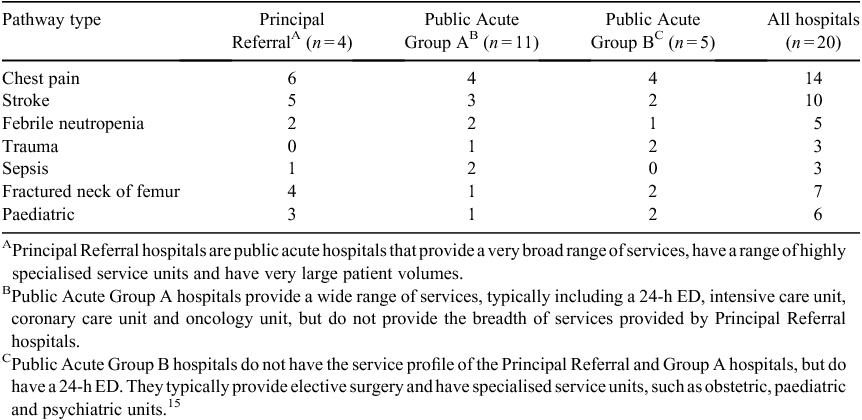
|
In-hours access to medical imaging for plain radiology, ultrasound and computed tomography (CT) was ubiquitously available with just one hospital reliant upon (~30 min by road vehicle) interhospital transfer for ultrasound and CT services. After-hours access (including on-call) was available for plain films (n = 20), CT (n = 19) and ultrasound (n = 15). Magnetic resonance imaging was less readily available, with in-hours availability in nine EDs and after-hours (or on-call) available in eight. Interventional radiology was available in-hours in seven EDs and after-hours on-call only in three. Pathology services were accessible to all EDs in terms of formal laboratory testing, blood gas analysis or point-of-care testing.
Output models
Output models included those that sought to facilitate the relocation of the patient to another area and thus reduce congestion in the ED. These included short stay wards and strategies aimed at making the ED–ward interface more efficient.
Short stay units
All EDs had an associated SSU, and used a <24-h LOS guiding policy, except one that used a 48-h LOS policy. Hospitals varied in the types of patients they admitted to the SSU, as indicated in Table 5.
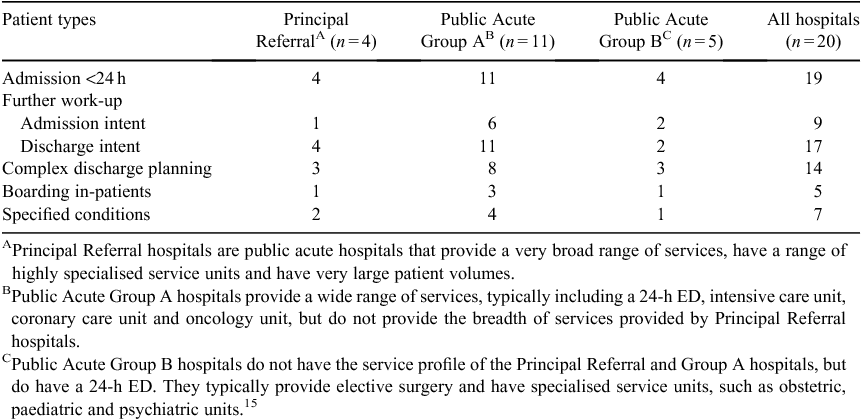
|
The proportion of ED patients admitted to the SSU varied by hospital level, with Principal Referral hospitals admitting 12.6% of patients, Group A hospitals admitting 9.6% of patients and Group B hospitals admitting 7.6% of patients. Overall, 85% (n = 17) reported that patients were admitted with the intent of being discharged, although some (45%, n = 9) also used the SSU to work-up patients for admission. Five hospitals reported that they used the SSU to board in-patients. The SSU was used as a location to facilitate complex discharge planning in 70% (n = 14) or for the management of specific conditions in 35% (n = 7). The median (interquartile range, IQR) of beds in the SSU was 8.0 (4.0–21.0). Mean admission rates from the ED were 10.3 ± 5.4%, and in-patient conversion (excluding boarded in-patients) was 12.8 ± 7.1%. The mean occupancy rate at any given time in SSUs was 91.0 ± 9.0%, with the exception of one SSU that ran at 58%. Although SSU nursing staff were present 24 h a day, dedicated medical staffing levels were incomplete with reduced or absent cover after-hours. Only 12 EDs had in-hours consultant cover and five had evening consultant cover. Registrars covered four SSUs in-hours and three SSUs in the evenings, whereas residents covered five SSUs during the day and three SSUs during the evening. No ED reported dedicated medical cover overnight.
ED–in-patient interface models
Initiatives were also reported that sought to facilitate the transition of in-patients out of the ED.
In-patient admission facilitation
Direct admission protocols were used in 75% (n = 15) of hospitals, although this was restricted to certain hours in all but four departments. Suitable patients were nominated by the ED consultant in nine EDs, by the accepting team in seven hospitals and by the receiving ward in three hospitals. Five departments (26.7%) transferred all stable patients, and ‘Pull’ strategies were used by the ward staff in 26.7% (n = 4).
MAUs were present in 55% (n = 11) of hospitals. Of those, the unit was collocated with the ED in 9% (n = 1) and distant in 91% (n = 10). Of all the units reported, 91% (n = 10) had in-patient team governance, and 27% (n = 3) had ED or shared governance. Eligible patients could be streamed directly from triage in 27% (n = 3). In all but 9% (n = 1), MAUs operated 24 h per day.
From a governance perspective, sites described a patient flow unit to manage hospital beds in 65% (n = 13). Operationally, models were nurse led 100% of the time, with one hospital receiving medical representation (5%; n = 1). Ninety per cent (n = 18) reported having an escalation plan during periods of ED overcrowding, with hospital executive authorisation being required in all. Six EDs were able to initiate an escalation plan before seeking executive endorsement.
Discharge facilitation and admission avoidance
Detailed information is presented in Table 6 regarding the principal strategies used by hospitals for either discharge facilitation or hospital avoidance in terms of governance, referral source and selected model characteristics. All hospitals reported Hospital in the Home (HITH), with 25% (n = 5) using a Hospital in the Nursing Home service, and 80% (n = 16) reporting liaison for community services for the elderly. Seventy-five per cent (n = 15) used a transit lounge model.
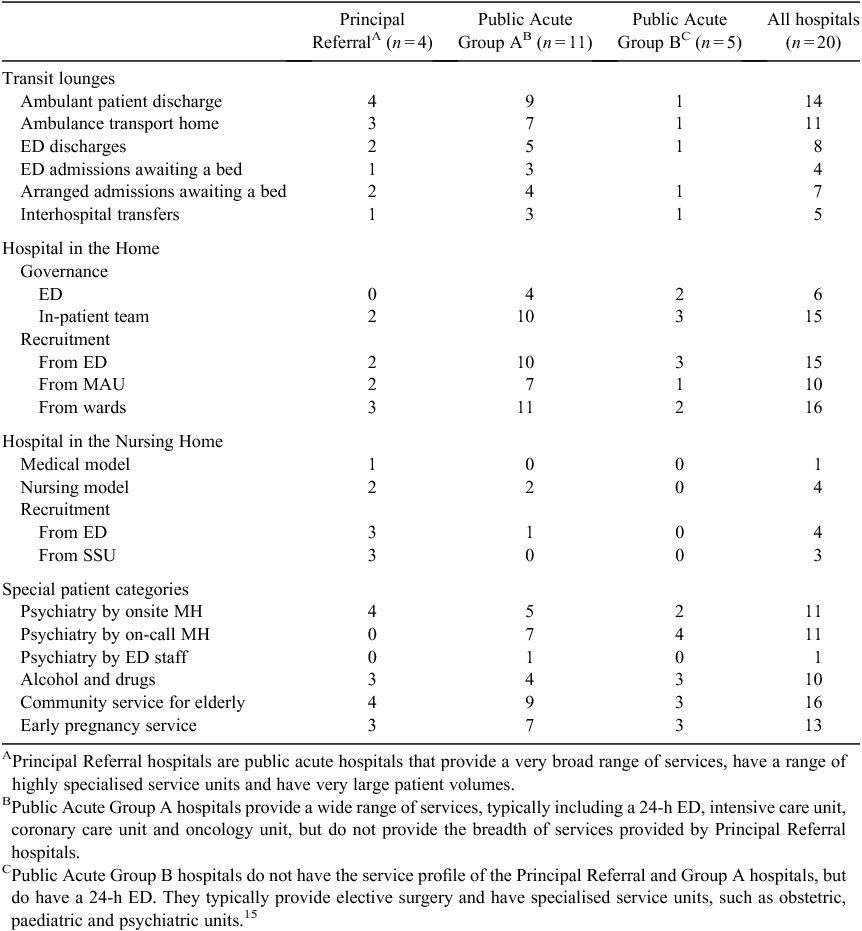
|
Discussion
EDs are as different as they are similar. When considering how resources are distributed and which MOC are in place, there are many factors that need to be considered, including patient demographics, the size and location of the hospital and the extent to which specialised services are available. As complex adaptive systems, EDs are dynamic places, under constant pressure at a given point in time in any or all of the areas of input and demand, throughput and output.14 Although many of the MOC attempt to deal with patient flow in a linear fashion, target specific phases of the ED journey or address particular patient cohorts, what is clear is that not all EDs are shaped and formed the same.
Our data suggest many MOC are widespread and well established. For example, the uptake of HITH and the use of transit lounges appears fairly consistent, as is the function of SSUs, which focus on patients who would be discharged or who require complex discharge planning (thereby producing low rates of subsequent admission).15
Equally, there are MOC that show real promise but as yet have not been taken up more broadly. For example, approaches to the care of the elderly or nursing home patients, 24-h access to direct admission and medical input to hospital bed management. So, opportunities exist to consider alternative models or make incremental changes to existing models to optimise ED performance.
Although ED crowding drives much research in this area, there is an increasing focus on quality measurement that needs to occur.14,16 For EDs to manage well, they are reliant upon the rest of the system working effectively to manage patient flow out of the department.8 In order for EDs to function in an evidence-based fashion, ambulances may be offloaded,17 triage processes proceed unhindered,18 patients streamed to appropriate treatment areas19 and early senior clinical input must be provided in order to make decisions about patient management and disposition.20 All these things need to occur in order for high-quality, timely patient care to be achieved.
When considering how to best structure early physician input, a range of advantageous options exist, including physician-led triage over a sequential nurse–physician model,21,22 physician-assisted triage (PAT),23,24 senior streaming assessment after triage25 or front loading through facilitated team leadership and the application of a 2-h subtarget for disposition.20 With one-third of EDs reporting some form of physician input in the triage phase and two-thirds indicating early physician assessment, it would appear that some of the evidence is being translated. What may be lacking, from an analysis of the survey data, is the articulation of the above models with appropriate reductions in the need for internal handover, specified 2-h decision-making, the use of internal step-down areas and explicit SMO referral that forces periodic cubicle turnover.20 Furthermore, the application of functional pod areas to segment flows according to high and low clinical variability appears beneficial,26 but was reportedly lacking in Queensland EDs. Sequential implementation of PAT and MAU models has recently been described to improve performance beyond the sum of their parts.24
It would appear that MOC targeting patients from aged care facilities or the frail elderly could provide the next wave of implementation for Queensland EDs, with only one-quarter reporting a Hospital in the Nursing Home program. From the literature concerning residents from aged care facilities, these programs serve to define goals of care,27 reduce ED attendance,28,29 reduce ED LOS,27,28 reduce hospital admission,27,29 reduce hospital LOS,28 increase rates of comprehensive geriatric assessment and facilitate supported discharge in the primary place of residence30 with an option of outreach into the aged care facility.31 A comprehensive evaluation of an ED-based service for all older people, whether from the community or aged care facilities, presenting to the ED is under way.32
Limitations
There are several limitations to the present study that may affect the ability to generalise findings, and the results need to be interpreted accordingly. First, this study was undertaken in one Australian state and not all EDs responded to the questionnaire. However, the 74% response rate did reflect EDs of varying sizes, locations and community profiles. Second, although we did request supporting protocols for MOC used, these were either not available or were not consistently provided. Third, information on the distribution of medical and nursing staff reported within each ED MOC was not explicitly sought, but 24-h medical, nursing and allied health staffing profiles are the subject of a future study.
Conclusion
There is considerable variability in the MOC used throughout Queensland EDs. There would be value derived from a more consistent and comprehensive approach, but this depends on a more complete analysis of the relative effectiveness of different MOC either in isolation or as part of a comprehensive approach. There are MOC that show real promise but as yet have not been taken up more broadly. It would appear that MOC targeting patients from aged care facilities or the frail elderly could provide the next wave of implementation for Queensland EDs.
Competing interests
The authors have no conflicts of interests to declare.
Acknowledgements
The authors thank the Healthcare Improvement Unit of the Queensland Government’s Department of Health for providing the ED implementation system data, and the ED staff of the participating hospitals who completed and returned the survey questionnaires. Funding for this study was provided by the Emergency Medicine Foundation (EMPJ-12-185-Bell-Swamped). This funding supported Ghasem-Sam Toloo’s salary and data collection costs. The funding agency had no role in study design, data collection and analysis, decision to publish or preparation of the manuscript.
References
[1] Australian Institute of Health and Welfare (AIHW). Australian hospital statistics 2008–09. Catalogue no. HSE 84. Canberra: AIHW; 2010.[2] Australian Institute of Health and Welfare (AIHW). Australian hospital statistics 2013–14: emergency department care. Catalogue no. HSE 153. Canberra: AIHW; 2014.
[3] Australian Institute of Health and Welfare (AIHW). Emergency department care 2015–16: Australian hospital statistics. Canberra: AIHW; 2016.
[4] Bernstein SL, Aronsky D, Duseja R, Epstein S, Handel D, Hwang U, McCarthy M, John McConnell K, Pines JM, Rathlev N, Schafermeyer R, Zwemer F, Schull M, Asplin BR. Society for Academic Emergency Medicine, Emergency Department Crowding Task Force. The effect of emergency department crowding on clinically oriented outcomes. Acad Emerg Med 2009; 16 1–10.
| Society for Academic Emergency Medicine, Emergency Department Crowding Task Force. The effect of emergency department crowding on clinically oriented outcomes.Crossref | GoogleScholarGoogle Scholar |
[5] Johnson KD, Winkelman C. The effect of emergency department crowding on patient outcomes: a literature review. Adv Emerg Nurs J 2011; 33 39–54.
| The effect of emergency department crowding on patient outcomes: a literature review.Crossref | GoogleScholarGoogle Scholar |
[6] Sullivan C, Staib A, Griffin B, Bell A, Scott I. The four hour rule: the National Emergency Access Target in Australia – systematic literature review. Canberra: CSIRO; 2015.
[7] Sullivan C, Staib A, Khanna S, Good NM, Boyle J, Cattell R, Heiniger L, Griffin BR, Bell AJ, Lind J, Scott IA. The National Emergency Access Target (NEAT) and the 4-hour rule: time to review the target. Med J Aust 2016; 204 354
| The National Emergency Access Target (NEAT) and the 4-hour rule: time to review the target.Crossref | GoogleScholarGoogle Scholar |
[8] Khanna S, Sier D, Boyle J, Zeitz K. Discharge timeliness and its impact on hospital crowding and emergency department flow performance. Emerg Med Australas 2016; 28 164–70.
[9] Toloo GS, Burke J, Crilly J, Williams G, McCann B, Fitzgerald G, Bell A. Understanding ED performance in the context of activity based funding. Int J Health Plan Managt 2017; 33 405–13.
| Understanding ED performance in the context of activity based funding.Crossref | GoogleScholarGoogle Scholar |
[10] Asplin BR, Magid DJ, Rhodes KV, Solberg LI, Lurie N, Camargo CA. A conceptual model of emergency department crowding. Ann Emerg Med 2003; 42 173–80.
| A conceptual model of emergency department crowding.Crossref | GoogleScholarGoogle Scholar |
[11] Wylie K, Bell AJ, Fitzgerald G, Crilly J, Toloo GS, Burke J. The implications of activity based funding for emergency departments: a comprehensive literature review. Brisbane: Queensland University of Technology; 2014.
[12] Wylie K, Crilly J, Toloo GS, FitzGerald G, Burke J, Williams G, Bell A. Review article: emergency department models of care in the context of care quality and cost: a systematic review. Emerg Med Australas 2015; 27 95–101.
| Review article: emergency department models of care in the context of care quality and cost: a systematic review.Crossref | GoogleScholarGoogle Scholar |
[13] Australian Institute of Health and Welfare (AIHW). Hospital resources 2013–14: Australian hospital statistics (Appendix A: database quality statement summary). Canberra: AIHW; 2015.
[14] Bergs J, Vandijck D, Hoogmartens O, Heerinckx P, Van Sassenbroek D, Depaire B, Marneffe W, Verelst S. Emergency department crowding: time to shift the paradigm from predicting and controlling to analysing and managing. Int Emerg Nurs 2016; 24 74–7.
| Emergency department crowding: time to shift the paradigm from predicting and controlling to analysing and managing.Crossref | GoogleScholarGoogle Scholar |
[15] Department of Health. Emergency department short stay unit guideline and implementation standard. QH-GDL-352:2014. Brisbane: Queensland Government; 2014.
[16] Staib A, Clair S, Jones M, Griffin B, Bell AJ, Scott I. The ED–inpatient dashboard: uniting emergency and inpatient clinicians to improve the efficiency and quality of care for patients requiring emergency admission to hospital. Emerg Med Australas 2017; 29 363–6.
| The ED–inpatient dashboard: uniting emergency and inpatient clinicians to improve the efficiency and quality of care for patients requiring emergency admission to hospital.Crossref | GoogleScholarGoogle Scholar |
[17] Crilly J, Keijzers G, Tippett V, O’Dwyer J, Lind J, Bost N, O’Dwyer M, Shiels S, Wallis M. Improved outcomes for emergency department patients whose ambulance off-stretcher time is not delayed. Emerg Med Australas 2015; 27 216–24.
| Improved outcomes for emergency department patients whose ambulance off-stretcher time is not delayed.Crossref | GoogleScholarGoogle Scholar |
[18] Bergs J, Verelst S, Gillett J-B, Deboutte P, Vandoren C, Vandijck D. The number of patients simultaneously present at the emergency department as an indicator of unsafe waiting times: a receiver operated curve-based evaluation. Int Emerg Nurs 2014; 22 185–9.
| The number of patients simultaneously present at the emergency department as an indicator of unsafe waiting times: a receiver operated curve-based evaluation.Crossref | GoogleScholarGoogle Scholar |
[19] Wiler JL, Gentle C, Halfpenny JM, Heins A, Mehrotra A, Mikhail MG, Fite D. Optimizing emergency department front-end operations. Annals of Emergency Medicine 2010; 55 142–60.e1.
| Optimizing emergency department front-end operations.Crossref | GoogleScholarGoogle Scholar |
[20] Burke JA, Greenslade J, Chabrowska J, Greenslade K, Jones S, Montana J, Bell A, O’Connor A. Two hour evaluation and referral model for shorter turnaround times in the emergency department. Emerg Med Australas 2017; 29 315–23.
| Two hour evaluation and referral model for shorter turnaround times in the emergency department.Crossref | GoogleScholarGoogle Scholar |
[21] Burström L, Nordberg M, Ornung G, Castrén M, Wiklund T, Engström ML, Enlund M. Physician-led team triage based on lean principles may be superior for efficiency and quality? A comparison of three emergency departments with different triage models. Scand J Trauma Resusc Emerg Med 2012; 20 57
| Physician-led team triage based on lean principles may be superior for efficiency and quality? A comparison of three emergency departments with different triage models.Crossref | GoogleScholarGoogle Scholar |
[22] Burström L, Engstrom ML, Castrén M, Wiklund T, Enlund M. Improved quality and efficiency after the introduction of physician-led team triage in an emergency department. Ups J Med Sci 2016; 121 38–44.
| Improved quality and efficiency after the introduction of physician-led team triage in an emergency department.Crossref | GoogleScholarGoogle Scholar |
[23] Elder E, Johnston A, Crilly J. Review article: systematic review of three key strategies designed to improve patient flow through the emergency department. Emerg Med Australas 2015; 27 394–404.
| Review article: systematic review of three key strategies designed to improve patient flow through the emergency department.Crossref | GoogleScholarGoogle Scholar |
[24] Elder E, Johnston A, Crilly J. Improving emergency department throughput: an outcomes evaluation of two additional models of care. Int Emerg Nurs 2016; 25 19–26.
| Improving emergency department throughput: an outcomes evaluation of two additional models of care.Crossref | GoogleScholarGoogle Scholar |
[25] Shetty A, Gunja N, Byth K, Vukasovic M. Senior streaming assessment further evaluation after triage zone: a novel model of care encompassing various emergency department throughput measures. Emerg Med Australas 2012; 24 374–82.
| Senior streaming assessment further evaluation after triage zone: a novel model of care encompassing various emergency department throughput measures.Crossref | GoogleScholarGoogle Scholar |
[26] Arya R, Wei G, McCoy JV, Crane J, Ohman-Strickland P, Eisenstein RM. Decreasing length of stay in the emergency department with a split emergency severity index 3 patient flow model. Acad Emerg Med 2013; 20 1171–9.
| Decreasing length of stay in the emergency department with a split emergency severity index 3 patient flow model.Crossref | GoogleScholarGoogle Scholar |
[27] Hullick C, Conway J, Higgins I, Hewitt J, Dilworth S, Holliday E, Attia J. Emergency department transfers and hospital admissions from residential aged care facilities: a controlled pre-post design study. BMC Geriatr 2016; 16 102
[28] Craswell A, Coates K, Taylor A, Marsden E, Crilly J, Glenwright A, Wallis M. Streamlining care of older people in residential aged care: nurse practitioner candidate and emergency department care coordination. J Nurse Pract 2017; 13 e340–1.
| Streamlining care of older people in residential aged care: nurse practitioner candidate and emergency department care coordination.Crossref | GoogleScholarGoogle Scholar |
[29] Fan L, Zhao J, Sun J, Dingle K, Purtill R, Tapp S, Lukin B. Hospital in the Nursing Home program reduces emergency department presentations and hospital admissions from residential aged care facilities in Queensland, Australia: a quasi-experimental study. BMC Health Serv Res 2016; 16 46
[30] Craswell A, Marsden E, Taylor A, Wallis M. Emergency department presentation of frail older people and interventions for management: geriatric emergency department intervention. Saf Health 2016; 2 1–6.
| Emergency department presentation of frail older people and interventions for management: geriatric emergency department intervention.Crossref | GoogleScholarGoogle Scholar |
[31] Burkett E, Scott I. CARE-PACT: a new paradigm of care for acutely unwell residents in aged care facilities. Aust Fam Physician 2015; 44 204–9.
[32] Marsden E, Taylor A, Wallis M, Craswell A, Broadbent M, Barnett A, Nguyen KH, Crilly J, Johnston C, Glenwright A. A structure, process and outcome evaluation of the geriatric emergency department intervention model of care: a study protocol. BMC Geriatr 2017; 17 76


